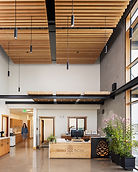


Asthetic Versitility
Precast Colors, Finishes and Textures
At Missoula Concrete Construction, our precast concrete can be molded into almost any shape, texture, or size. This allows architects and owners to explore:


BRICK • GRANITE • CERAMIC • ACID ETCHING • ABRASIVE PATTERNS • PAINT • PORCELAIN • MARBLE • EXPOSED AGGREGATE • MATTE • SLATE • SAND EMBEDMENT • GRAPHIC IMAGES • TOOLING
%20(15%20x%209_5%20in)%20(17%20x%209_5%20in)%20(6).png)

Pigments
The versatility of colors and pigments in precast concrete is a major advantage in architectural, landscaping, and infrastructure applications. Pigments are mixed into the concrete before casting, resulting in a consistent color throughout. Stains and dyes can also be applied to the surface after casing, allowing for layering effects or patterning.
BLACK PIGMENTS
TAN/ BUFF PIGMENTS
MULTI-COLOR PIGMENTS
BROWN PIGMENTS
GREY PIGMENTS
WHITE PIGMENTS



Architects can specify different surface finishes to be applied during the casting process such as light, medium, or heavy sandblasting, to acid washing and exposed aggregate. Embedded materials like glass, stone or metal can also be incooporated into the surface of precast panels.
Finish
Textures
ACID ETCHED TEXTURES
RETARTER TEXTURES
SANDBLAST TEXTURES
Click pigment colors to expand













Custom Textures Achieved with Form Liners
Using molds or liners, precast can take on the texture of almost any material:
-
Wood grain – mimics planks or rough-sawn timber
-
Stone patterns – such as limestone, slate, or ashlar stone
-
Abstract patterns – geometric, organic, or custom designs (logos, art, etc.)
-
Ribbed or fluted surfaces – adds rhythm and shadow to facades
Textures are cast into the concrete, making them durable with little required maintenance.
Unlimited Clay Facade Colors and Layouts
Clay facade surfaces offer a completely custom look in unlimited options. Even custom colors can be achieved.
Facades such as thin brick, terracotta tiles and ceramic cladding can be cast onto the surface of each precast panel.
This hybrid system offers aesthetic versatility, structural strength and faster installation when compared to traditional masonry systems.
Thin Brick • Ceramic • Porcelain • Terra Cotta
Custom Graphics Achieved with a Retarder Membrain
Through a specialized process, any pattern or image can be cast into the surface of precast panels using a dot matrix system. The pattern is printed onto a membrain with a surface retarder. The membrain is then placed face up into the concrete mold. After curing, the membrain is removed, exposing the aggregate and pattern beneath.
With unlimited pattern options, architects can create unique, large-scale imagery or branding.




Unlimited Paint, Matt and Textured Finishes
Whatever vision your design team has for the project, we can emulate. There are unlimited ways to make a simple surface enhance your project in an economical way. Light, medium, or heavy sandblasting, as well as acid washing, exposed aggregate, and paint can all be applied to achieve the custom look you want.




Patterns with Sand or Abrasive Blasting
Sandblasting is a widely used technique for creating custom patterns, textures, and images on precast concrete panels. It works by selectively eroding the concrete surface using high-pressure air and abrasive material (usually sand or grit), revealing aggregate or creating depth variation. A rubber stencil or resist mask is applied to the surface of the concrete and then sandblasting reveals the aggregate around the stencil, making it possible to create any imagery, art, or branding.




Historical Restoration and Adaptive Reuse
The Butte-Silver Bow Public Archives is the perfect example of how precast can emulate any look, even emulating a historical design. The building underwent a significant restoration project that included the construction of a new archival vault and the rehabilitation of the historic firehouse it occupies. The process involved working together with A&E Design and the community to restore, enhance, and preserve the history of the building through the process of adaptive resuse.






















































































































.jpg)
.jpg)
.jpg)
.jpg)